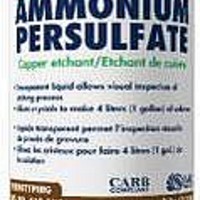410-1KG MG Chemicals, 410-1KG Datasheet - Page 3

410-1KG
Manufacturer Part Number
410-1KG
Description
Chemicals AMMONIUM PERSULPHATE
Manufacturer
MG Chemicals
Datasheet
1.410-1KG.pdf
(4 pages)
Specifications of 410-1KG
Product
Prototyping/Board Repair
Chemical Component
Ammonium Persulphate
Density, Vapor
1.6
Dispensing Method
Bottle
Primary Type
Etchant
Specific Gravity
1.98
Weight
2.2 lbs.
Lead Free Status / RoHS Status
Lead free / RoHS Compliant
For Use With
Etching printed circuits boards
Section 6: Accidental Release Measures
Spill
Procedure:
Section 7: Handling and Storage
Handling: Use eye, skin and clothing protection. Do not ingest or inhale. Do not expose container to heat. Diluted
Storage:
Section 8: Exposure Controls
Routes of
entry:
Ventilation:
Personal
Protection:
Section 9: Physical and Chemical Properties
Section 10: Stability and Reactivity
Section 11: Toxicological Information
Physical
State:
Boiling
Point:
Stability:
Conditions to
avoid:
Incompatibilities:
Polymerization:
Decomposition:
Sensitization: (effects of repeated
exposure)
Carcinogenicity: (risk of cancer)
Teratogenicity: (risk of malformation in
an unborn fetus)
Reproductive Toxicity: (risk of sterility)
Mutangenicity: (risk of heritable genetic
effects)
Lethal Exposure
Concentrations:
product must be stored in a vented container as it will gas off and create pressure in a sealed container.
Store in a cool, dry, well-ventilated area, away from incompatible substances.
Sweep dry material into a plastic container. Provide adequate ventilation. For diluted material, sprinkle
absorbent compound onto spill, then sweep into a plastic container. Wipe up further residue with paper
towel and place into container. Wash spill area with soap and water.
White
crystals
N/a
Eyes, ingestion, inhalation, and skin.
Use adequate general or local exhaust ventilation to keep airborne concentrations below exposure
limits.
Wear appropriate protective eyeglasses or chemical safety goggles. Wear rubber or neoprene
protective clothing to prevent skin contact. Use a NIOSH approved respirator when necessary.
Stable (becomes unstable in presence of heat, moisture and/or contamination.
Heat, moisture and contamination.
Acids, alkalis, halides (fluorides, chlorides, bromides and iodides), combustible materials,
most metals and heavy metals, oxidizable materials and other oxidizers, reducing agents,
cleaners, and organic or carbon containing compounds. Contact with incompatible materials
can result in a material decomposition or other uncontrolled reactions.
Will not occur.
Oxygen that supports combustion and oxides of sulfur.
Ingestion
Gravity:
Specific
(LD50):
Odor:
None
1.98
742 mg/kg
(Male rat)
May cause skin sensitization, an allergic reaction, which becomes
evident upon re-exposure to this material.
No
No
No
No
PAGE 2 / 4
Solubility:
Pressure:
Vapor
Inhalation
(LC50):
85g @25°C
by weight
N/a
2.95mg/l
(4h)(Rat)
Registered Quality System ISO 9001
Evaporation
Burlington, Ontario, Canada
Density:
Vapor
QMI Certificate #004008
Rate:
(LD50):
MSDS Code: 410
Skin
N/a
N/a
2000mg kg
Rabbit)
pH:
/
4



